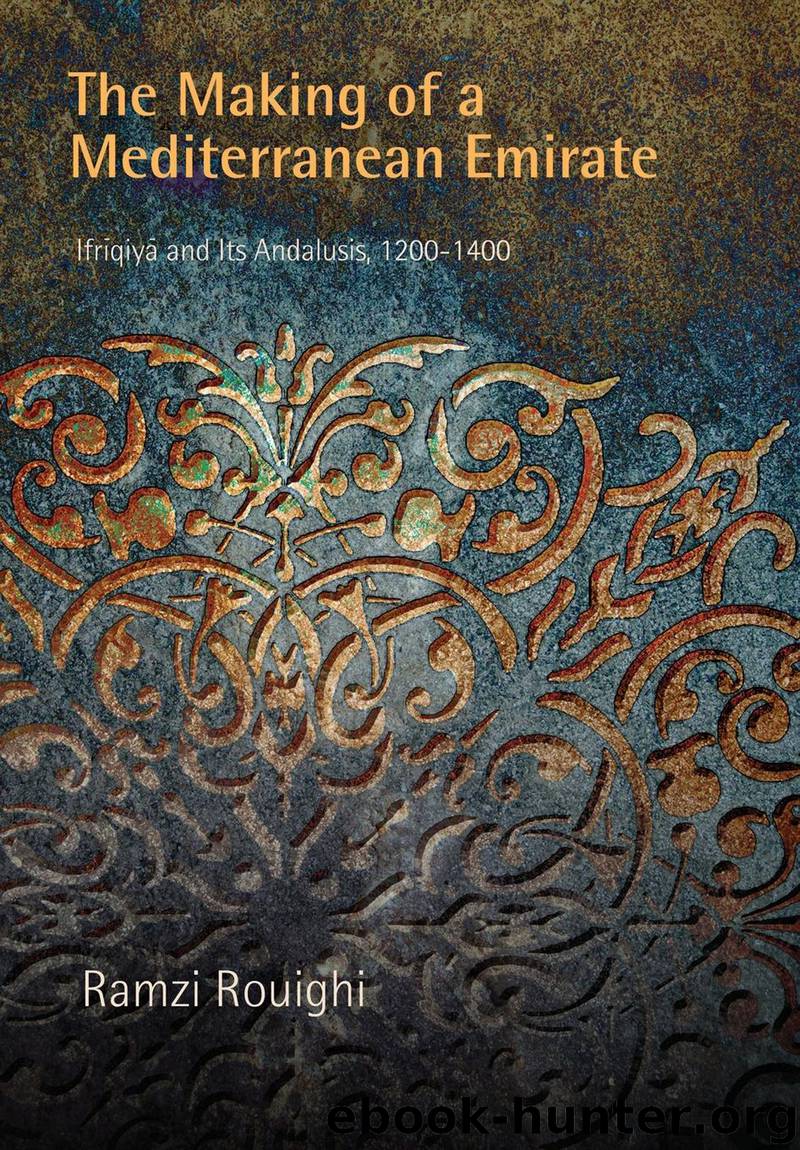The Making of a Mediterranean Emirate by Rouighi Ramzi;

Author:Rouighi, Ramzi;
Language: eng
Format: epub
Publisher: University of Pennsylvania Press
Published: 2019-04-15T00:00:00+00:00
Schooling the Emirate
Schools, Teachers, and Students
Most teachers who taught the basics—reading, writing, and the Qur’ān—did not write books. They mostly lectured. Sometimes their students’ lecture notes were preserved long after their death. The labor of these intellectuals often appears in the anecdotes, allegories, and sayings narrated in contemporary texts. Through their teaching, teachers took part in the maintenance of a basic referential universe shared among those who received at least some education. In other words, teachers knitted patterns of thought that contributed to the establishment of intellectual commonplaces in Ifrīqiyā.
The primary function of these teachers was to circulate ideas that were distilled into tidbits, but most of those ideas were not of their own making. In fact, most teachers were not fully in control of the material they covered. Other than a few, and often famous, luminaries, most teachers could not engage in a systematic analysis of the assumptions on which disciplinary knowledge was founded. They lacked the training, capacity, and leisure to do so, but by simply relaying certain ideas to the exclusion of others, they performed an invaluable ideological task.
In primary school (kuttāb, pl. katātīb), children received a rudimentary or primary education that consisted mostly of learning to read and write, and of committing at least some of the Qur’ān to memory. At the kuttāb, children also listened to lectures about the Prophet, his sayings and deeds, and a host of stories and lore about famous individuals and places. As Ibn Khaldūn reports, in Ifrīqiyā most primary teachers were Andalusi:
The people of Ifrīqiyā usually combine the instruction of children in the Qur’ān with the teaching of traditions…. In general, their method of instruction in the Qur’ān is closer to the Andalusi method (than to the western Maghribī or Eastern methods), because [their educational tradition] derives from the Andalusi sheikhs who crossed over when the Christians conquered al-Andalus and asked for hospitality in Tunis. From that time on, they were the teachers of [Ifrīqiyā’s] children.8
The majority of teachers cited in the ‘Unwān al-dirāya, the biographical dictionary of notable intellectuals in Bijāya in the thirteenth century, were either Andalusi or immigrants of Andalusi origin. In addition to the kuttāb, elementary education took place in mosques, where students of varying levels of competency studied.
The sons and daughters of the elite also received instruction from private teachers.9 From early childhood, the elite of Ifrīqiyā maintained a clear separation between their children and those they were to govern, hiring preceptors of quality to educate their children.10 The famous Andalusi litterateur Ibn ‘Uṣfūr (d. 1271), who had migrated to Ifrīqiyā from Seville, was one of the most celebrated of these teachers. He taught the Ḥafṣid emir Yaḥyā in Bijāya, and when he moved to Tunis had among his students the future caliph al-Mustanṣir (r. 1249–77).11
More advanced students attended lectures at the various mosques in the city. The two largest mosques in Bijāya were the Great Mosque (al-jāmi‘ al-a‘ẓam) and the Mosque of the Kasbah (masjid al-Qaṣaba).12 They were both institutions of higher, or more advanced, learning that trained countless officials.
Download
This site does not store any files on its server. We only index and link to content provided by other sites. Please contact the content providers to delete copyright contents if any and email us, we'll remove relevant links or contents immediately.
| Africa | Americas |
| Arctic & Antarctica | Asia |
| Australia & Oceania | Europe |
| Middle East | Russia |
| United States | World |
| Ancient Civilizations | Military |
| Historical Study & Educational Resources |
The Travels of Reverend Ólafur Egilsson: The Story of the Barbary Corsair Raid on Iceland in 1627 by Ólafur Egilsson & Karl Smári Hreinsson(593)
Pirates of Barbary: Corsairs, Conquests and Captivity in the Seventeenth-Century Mediterranean by Adrian Tinniswood(527)
Phantom Major by Virginia Cowles(397)
The Iberian World by Fernando Bouza;Pedro Cardim;Antonio Feros;(379)
The Battle for North Africa by Glyn Harper(363)
The Animal in Ottoman Egypt by Alan Mikhail(361)
Roman Legionary vs Carthaginian Warrior by David Campbell(355)
Eritrea at a Crossroads by Andebrhan Welde Giorgis(333)
The Barbary Wars by Frank Lambert(329)
Collapse of a Country: A Diplomat's Memoir of South Sudan by Nicholas Coghlan(328)
The End of Barbary Terror: America's 1815 War against the Pirates of North Africa by Frederick C. Leiner(307)
Christianity in Roman Africa by Burns J. Patout Jr.; Jensen Robin M.; & Robin M. Jensen(303)
The Sands of Kalahari by William Mulvihill(286)
A History of the Mediterranean Air War 1940–1945 by Christopher Shores(280)
Morocco by C. R. Pennell(270)
A Line in the River by Jamal Mahjoub(250)
The Holocaust and North Africa by Aomar Boum Sarah Abrevaya Stein(246)
The Making of a Mediterranean Emirate by Rouighi Ramzi;(244)
A History of South Sudan by Rolandsen Øystein H. & Daly M. W. & Rolandsen Øystein H. & Daly M. W(242)
